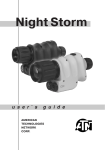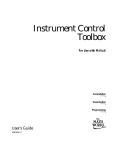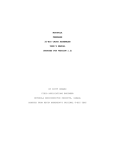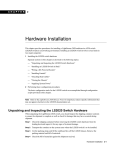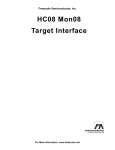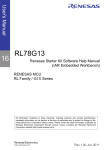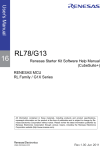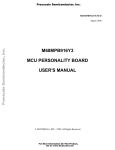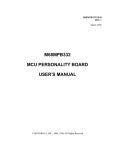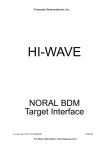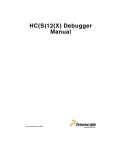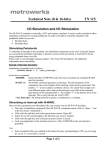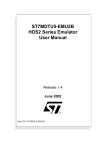Download ICD Target Interface
Transcript
HI-WAVE ICD Target Interface © Copyright 1998 HIWARE HI-WAVE Product Manual Manual Date HI-WAVE - ICD 12/98 © Copyright 1998 HIWARE HI-WAVE 3 Contents IMPORTANT. . . . . . . . . . . . . . . . . . . . . . . . . . . . . . . . . . 5 NT Installation Notice . . . . . . . . . . . . . . . . . . . . . . . . . . . 5 ICD Target Interface . . . . . . . . . . . . . . . . . . . . . . . . . . . . 7 Introduction . . . . . . . . . . . . . . . . . . . . . . . . . . . . . . . . . . . . . . . . . . . 7 Interfacing Your System and ICD . . . . . . . . . . . . . . . . . . . . . . . . . . 8 Loading the ICD Target Component . . . . . . . . . . . . . . . . . . . . . . . . 9 Default Target Setup . . . . . . . . . . . . . . . . . . . . . . . . . . . . . . . . . . . 10 ICD Default Environment . . . . . . . . . . . . . . . . . . . . . . . . . . . . . . . . . . . . . . . . . . . 10 Command Files and ICD commands . . . . . . . . . . . . . . . . . . . . . . . . . . . . . . . . . . 12 Memory Configuration. . . . . . . . . . . . . . . . . . . . . . . . . . . . . . . . . . 17 System Configuration for a CPU32 . . . . . . . . . . . . . . . . . . . . . . . . . . . . . . . . . . . 18 System Configuration for a CPU16 . . . . . . . . . . . . . . . . . . . . . . . . . . . . . . . . . . . 20 Examples of “Reset.cmd” File . . . . . . . . . . . . . . . . . . . . . . . . . . . . . . . . . . . . . . . 21 Board Configuration for the MPFB1632 . . . . . . . . . . . . . . . . . . . . . . . . . . . . . . . 24 References . . . . . . . . . . . . . . . . . . . . . . . . . . . . . . . . . . . . . . . . . . . 27 © Copyright 1998 HIWARE HI-WAVE 4 © Copyright 1998 HIWARE HI-WAVE IMPORTANT IMPORTANT NT Installation Notice In order to access the parallel port of a Host running Windows NT, a special driver has to be installed. To install this driver, after installing the HIWARE Development Kit on the Host, run the setup program called “icd_dr.bat“. This program is located in the directory “prog\drivers\Nt\ICD“ in the HIWARE installation on the Host. You can also run this program from the “ICD driver setup” folder in your installation group or choose from Windows Taskbar “Start | Programs | Hiware | ICD driver setup | Win NT driver”. © Copyright 1998 HIWARE © Copyright 1998 HIWARE ICD Target Interface 7 ICD Target Interface Introduction Another advanced feature of HI-WAVE for the embedded system development world is the ability to load different framework targets. The ICD Background Debug Interface is introduced in this document. The ICD is an interface developed by P&E Microcomputer Systems and used by HI-WAVE to communicate with an external system also called target system. With this interface, you can download an executable program from the HI-WAVE environment to an external target system based on a Motorola MCU which will execute the program. You will also have the feedback of the real target system behavior to HI-WAVE. HI-WAVE will fully supervise and monitor the MCU of the target system i.e. control the CPU execution. You can read and write in internal/external memory when the MCU is in Background Mode. You have full control over the CPU state with the possibility to stop execution, to proceed in single step mode and to set breakpoints in the code. Note: The ICD target component is not included in the HI-WAVE base installation. © Copyright 1998 HIWARE HI-WAVE 8 Interfacing Your System and ICD Interfacing Your System and ICD A parallel to serial interface is used for the communication between ICD target and host computer. The communication to the target is serial. The communication protocol between the ICD and host is fully handled by the ICD Target driver which is automatically loaded with the ICD Target Component. The Centronics (printer) cable must be as short as possible (if not completely removed) between the host and the ICD interface to avoid communication troubleshoutings. LPT n parallel communication ICD Link Printer Cable ICD cable Host Computer © Copyright 1998 HIWARE Target System serial communication HI-WAVE ICD Target Interface 9 Loading the ICD Target Component Usually the target is set in the PROJECT.INI file, where Target=Icd (please see also next section). The ICD driver detects automatically that the ICD is connected to your system. However, if nothing is detected, an error message pops up and informs you that the target is not connected or is connected to a different port. If no target is set in the PROJECT.INI file or if a different target is set, you can load the ICD driver selecting Component | Set Target... in the main menu as shown below and choose Icd in the list of proposed targets. After a successful target loading, the Target menu item is replaced by ICD. Selecting Icd | Force BDM triggers a reset of the target, forces the CPU into background mode and executes the command files “forcebdm.cmd” and “reset.cmd”. (See section Command Files). Selecting Icd | Reset triggers a reset of the target and executes the command file “reset.cmd”. Choose Icd | Load.. to load an executable file (“.abs”) into the memory of the target. The program counter will point at the first instruction of the startup section. © Copyright 1998 HIWARE HI-WAVE 10 Default Target Setup Default Target Setup As any other target, the ICD target component can be loaded from the Target menu or can be set as a default target in the PROJECT.INI file which should be located in the working directory. Example of PROJECT.INI file: Window0=Source Window1=Assembly Window2=Procedur Window3=Register Window4=Memory Window5=Data Window6=Command Target=ICD 0 60 0 60 60 0 0 0 0 30 30 60 55 78 60 40 60 40 40 60 60 30 30 25 30 40 23 22 ICD Default Environment As any HI-WAVE program, the ICD target component parameters can be set in the DEFAULT.ENV file which should be located in the working directory. Under normal usage, these parameters are once interactively set at installation in the DEFAULT.ENV file and used in future debugging sessions. The environment variables associated to the ICD target component are introduced below. ICDPORT This variable is used to specify (to the host) the parallel communication port where the ICD is connected. Syntax ICDPORT=LPTn ICDPORT=LPTn: ICDPORT=portAddr where n: number of used printer port (1,2) © Copyright 1998 HIWARE HI-WAVE ICD Target Interface 11 portAddr: address of used printer port (1,2). The possibility to specify the address of the used printer port is only possible with Windows 95 and Windows 3.1x with Win32s. Under Windows NT, the access to a port has to be handled by a driver which evaluates the address of the specific port itself. Therefore it is not possible to specify a port address. Do first try to define the Icd-Port by name, e.g. LPT1 or LPT2. Define the communication port by address only if it is necessary (when not possible by name). Examples ICDPORT=LPT2 //Name of the port. Examples ICDPORT=0x378 //Address of the port. Default ICDPORT=LPT1 Note: ICDPORT=0x378 is the MS-DOS 1st parallel printer port address and ICDPORT=0x278 is the MS-DOS 2nd parallel printer port address. It could be necessary to specify the ICD port by address under some Win 3.x installations. BMDELAY This variable is used to slow down the communication speed of the serial link (ICD cable). The maximum speed available is given by the MCU clock speed, but the communication speed depends also on the PC. So if your target MCU is running with a clock speed below 1 MHz, then you may have to define a delay that is bigger than 0. Syntax BMDELAY=x where x: communication delay. Value counted from 0, where 0 is the fastest available speed. Example BMDELAY=9 You may have to try different values, starting from a high value (e.g. 150, 100, ...) until you find the optimal value for your system. Default Default value is 0. © Copyright 1998 HIWARE HI-WAVE 12 Default Target Setup Command Files and ICD commands For configuring the ICD target for a specific MCU and memory configuration, there are also some hints to consider. For the target initialisation a startup file “startup.cmd” is executed, when the ICD driver is loaded. Another command file “reset.cmd” is executed, when a reset has been triggered by the User selecting Icd | Reset. When the user selects Icd | Force BDM the command files “forcebdm.cmd” and “reset.cmd” are executed. The general Syntax of Command files is described in [CMDL]. Here are the commands that are defined for the ICD target component: ADRSPACE (for CPU32 only) Syntax ADRSPACE <address space> | RESET Where <address space> is a value from 0 to 7. This command allows to specify the address space which will be used for all memory accesses which will be done until another ADRSPACE command specifies a new value. Executing any target code or a reset will set the default address space which is supervisor code (e.g. run, trace, reset, ...) i.e. [FC2:FC0]=110. If RESET is specified, the previous value will be used again. This will allow to temporary change the address space and reset it again. Address space encoding: [FC2:FC0]=000 [FC2:FC0]=001 [FC2:FC0]=010 [FC2:FC0]=011 [FC2:FC0]=100 [FC2:FC0]=101 [FC2:FC0]=110 [FC2:FC0]=111 (0): Undefined, reserved for future use by Motorola (1): User Data Space (2): User Program Space (3): Undefined, reserved for user definition (4): Undefined, reserved for future use by Motorola (5): Supervisor Data Space (6): Supervisor Program Space (7): CPU Space Note: This command is available for CPU32 only. Please refer also to CPU32 Reference Manual from Motorola, section Processing States, Types of Address Space. © Copyright 1998 HIWARE HI-WAVE ICD Target Interface 13 CATCHTRAPS Goes in background mode when an exception is triggered. This command is used to catch interrupts and force the system to enter in background mode. There the actived interrupt can be retrieved. Syntax CATCHTRAPS <firstVec> <lastVec> [<address>] where <firstVec>: First interrupt vector captured <lastVec>: Last interrupt vector captured <address>: Address of the BGND instruction where the first vector points to. If no address is specified, a default address is chosen: The default for the HC16 is the address 0x200 and, for the CPU 32, a reserved space in the vector table (vector no. 16 up to 23) is used (vector base register + 0x48). Example (HC16) CATCHTRAPS 4 20 0x4300 The HC16 reserves the vector numbers from 0 to 3 for initial values (for ZK,SK,PK,PC,SP,IZ) after reset. So don’t overwrite them with CATCHTRAPS. At address 0x0000: XXXX XXXX XXXX XXXX 4300 4304 4308 The interrupt vectors are pointing now to the new defined interrupt handlers. At address 0x4300: 37A6 2777 37A6 2777 37A6 2777 For the HC16, for every interrupt vector, an own interrupt function (37A6 2777 = BGND RTI) is placed in the section specified with the address argument of CATCHTRAPS. The interrupt vector number is calculated by dividing the difference of the location address where the MCU halted (BGND instruction) and the address of the catch section specified, by 4. Assuming the MCU halted with BGND at 0x4308 in our example, we get (0x4308 - 0x4300) /4 = 2. The first vector catched was 4, so we know that the trap with vector number 6 (4+2) was triggered. Example (CPU32) CATCHTRAPS 2 20 0x4300 The CPU reserves the vector numbers from 0 to 1 for initial values (for SP, PC) after reset. So don’t overwrite them with CATCHTRAPS. At address 0x0000: XXXX XXXX XXXX XXXX 0000 4300 0000 The interrupt vectors are pointing now to the new defined interrupt handlers. © Copyright 1998 HIWARE HI-WAVE 14 Default Target Setup At address 0x4300: 4AFA 4E73 XXXX XXXX XXXX XXXX For the CPU32, only one catch routine (BGND RTE) is placed at the address specified. All interrupt vectors point to this same location. The interrupt vector is retrieved from the stackframe of the interrupt call. FORCEBDM Forces the target processor into Background Debug Mode (BDM). This also resets the processor and the target system. After reset, the command files FORCEBDM.CMD followed by RESET.CMD are executed. RESET Syntax RESET Triggers a reset of the target and executes the “reset.cmd” command file. The command is equivalent to selecting Icd | Reset. Please don’t issue a reset directly on the target, because the driver software does not notice it. Click Icd | Force BDM to reset the target and lead it back to your customized configuration by executing the reset command file. The command has no argument. TERMINAL Install a terminal emulation for the standart IO of the target. The terminal emulation is used to redirect the output of the target MCU to the output of the terminal component and to redirect the input on the Terminal component into an input buffer of the target memory that is used as input by the MCU. The Terminal emulation is based on a simple protocol for data exchange between the target MCU and the ICD driver. For the target application, the frame for data exchange is at a fixed address. For the ICD driver the address of the frame is defined at the address passed with the argument of the TERMINAL command. So the argument of the TERMINAL command depends on what address the target application expects the protocol frame to be installed at. Syntax TERMINAL [<address>] where <address>: Address, where the terminal emulation (protocol frame) is installed. © Copyright 1998 HIWARE HI-WAVE ICD Target Interface 15 A value of 0 disables the terminal emulation. How to use the Terminal component + Open the “Terminal” component with Component | Open | “Terminal” + Load the target application. + Execute “TERMINAL <address>” in the Command Line component window. Note: Currently, this command is executed from “reset”, “startup” and “forcebdm” files. + Start the application + The IO of a target application, that fits the protocol like the delivered example “termbgnd.c” is now redirected to the terminal. Note: When using the Calculator “calcbgnd.abs” program, the Terminal component must be opened first. Protocol Frame offset size comment 0 1 flag: !=0 -> char from terminal 1 1 character from terminal 2 2 0x5A5A :- string is written 0xA5A5 :- terminal is initialised 4 4 Address of string to receive. Protocol 0. Terminal initialisation (command TERMINAL <adr>) ICD Driver Target application writes 00 00 A5 A5 at <adr> 1. Target application writes a string to the terminal output ICD Driver Target application polls <adr>+2 for A5A5 writes the address of the string buffer at <adr>+4 writes 5A 5A at <adr>+2 © Copyright 1998 HIWARE HI-WAVE 16 Default Target Setup polls <adr>+2 for 5A5A gets string address at <adr>+4 reads the string sends the string to terminal output writes 5A 5A at <adr>+2 2. Target application reads a character from terminal input ICD Driver Target application Polls until byte at <adr> == 0 Writes terminal character at <adr>+1 Writes 01 at <adr> polls <adr> until byte at <adr> != 0 reads the byte from <adr>+1 resets the flag at <adr> to 0 Note: As the ICD driver and the target MCU exclude each other from access to the target memory by switching into BDM mode and back, this protocol is safe at the condition that the target application is running correctly and the memory space involved is not modified by the interacting user when the target is in background mode. VER Shows the version of all opened components including the ICD target. Syntax VER This command has no argument. © Copyright 1998 HIWARE HI-WAVE ICD Target Interface 17 Memory Configuration After a reset, only the boot chip select (CSBOOT) is configured. In order to access other memories, the chip select logic of the MCU has to be configured. This will normally be done by the startup code of your application. But for debugging, this needs to be done after each reset to allow you to load your application. For an appropriate configuration of chip selects for access to the external devices, you write your own startup and reset command files (“startup.cmd” and “reset.cmd”). Use the commands WB <address> <value> //write byte WW <address> <value> //write word (16 bit) WL <address> <value> //write long (32 bit) Note: Delivered command files match to the Motorola board default settings. (e.g. MPFB1632 board with 2 pseudo-ROM (RAMs) of 32k and no SRAM or FLASH. They are also adapted to MPB332AB boards supporting the MC68332, which as an internal 2kB RAM, and MPB16Y1B board supporting HC16Y1 which as also an internal 2kB RAM. Take a look at the delivered command files in your installation directory. Here is a short explanation of the most important system registers. Refer the manual of your MCU for a detailed description (See [MC68332] for CPU32 and [MC68HC16] for CPU16). Note: Each MCUs version has its own memory mapping. Software and hardware chip selects have to be done according to the MCU hardware and external hardware, i.e. ROM (pseudo-ROM), RAM (e.g. FLASH, SRAM), etc. © Copyright 1998 HIWARE HI-WAVE 18 Memory Configuration System Configuration for a CPU32 Important Registers of the SIM (System Integration Module): SYPCR (byte) at 0xFFFA21 - The System Protection Control Register. Specifies the Software watchdog disabling (BME=0) /enabling (BME=1), the watchdog timeout (bits SWT0/1) and some flags for bus monitoring. A watchdog trap (RESET) is issued when the MCU is running without periodically invoking a defined action, as for example reinitialising a dedicated register. For the CPU32 this is the SSR register, where first 0x55 and the 0xAA is written to. Watchdogs are implemented for stopping and reseting a MCU that is trapped in a loop or lost. SYNCR at 0xFFFA04 - Synthesizer control: Specifies the operation frequency related to the crystal. MCR at 0xFFFA00 - The module configuration register controls the SIM configuration CSPAR0 at 0xFFFA44 CSPAR1 at 0xFFFA46 - The pin assignement registers (CSPAR0/1) enable or disable chip select and determine the signals triggered on an access over a disabled chip select. Together with the assignements to the option register of a chip select (CSORBT for boot chip select and CSORB0,..,CSORB10 for the access to memory banks) can be fully configured. Each chip select has its own associated base register. The Registers CSBART for the boot block and CSBAR0,..,CSBAR10 for the other memory blocks. The following list summarises all base address and option registers: CSBARBT/CSORBT at 0xFFFA48 CSBAR0/CSOR0 at 0xFFFA4C CSBAR1/CSOR1 at 0xFFFA50 CSBAR2/CSOR2 at 0xFFFA54 CSBAR3/CSOR3 at 0xFFFA58 CSBAR4/CSOR4 at 0xFFFA5C CSBAR5/CSOR5 at 0xFFFA60 © Copyright 1998 HIWARE HI-WAVE ICD Target Interface 19 CSBAR6/CSOR6 at 0xFFFA64 CSBAR7/CSOR7 at 0xFFFA68 CSBAR8/CSOR8 at 0xFFFA6C CSBAR10/CSOR10 at 0xFFFA74 © Copyright 1998 HIWARE HI-WAVE 20 Memory Configuration System Configuration for a CPU16 The register naming is the same for the CPU16 and CPU32: SYPCR (byte) at 0xFFA21 SYNCR at 0xFFA04 MCR at 0xFFA00 CSPAR0 at 0xFFA44 CSPAR1 at 0xFFA46 CSBARBT/CSORBT at 0xFFA48 CSBAR0/CSOR0 at 0xFFA4C CSBAR1/CSOR1 at 0xFFA50 CSBAR2/CSOR2 at 0xFFA54 CSBAR3/CSOR3 at 0xFFA58 CSBAR4/CSOR4 at 0xFFA5C CSBAR5/CSOR5 at 0xFFA60 CSBAR6/CSOR6 at 0xFFA64 CSBAR7/CSOR7 at 0xFFA68 CSBAR8/CSOR8 at 0xFFA6C CSBAR10/CSOR10 at 0xFFA74 © Copyright 1998 HIWARE HI-WAVE ICD Target Interface 21 Examples of “Reset.cmd” File for the MC68HC16Y1 // This file is executed at the startup of HI-WAVE when running // the ICD debugger. It initializes some on chip registers of the // HC16 to enable accesses to internal and external memory devices. // It also contains commands to catch all the possible interrupts // and traps by setting up all the entries in the vector table // to point to a BGND instruction. // Initialization file for the MPFB1632 evaluation board (Modular Platform // Board) with two HM62256 RAM devices installed on U2 and U4B sockets // as pseudo-ROM with "word" addressing size. Note that this is the default // MPFB1632 board configuration. // Only boot cs (chip select) is used. // On chip (internal) 2 K RAM of the MC68HC16Y1 is used as SRAM. // To modify cs and the memory map, please refer to "MC68HC16Y1 Technical // Summary" from // Motorola, section "Chip Selects". // For further board details and hardware modifications, please refer to // M68MPFB1632 MODULAR PLATFORM BOARD USER'S MANUAL from MOTOROLA. // Force Background Mode // Reset the processor and enter // background mode ww 0xFFA20 0x0004 // System protection ww 0xFFA04 0x7F00 // Synthesizer control ww 0xFFA00 0x40CF // Module configuration // // Initialize chip select logic // // ROM emulation [0x0000..0x3FFF] (word accessible only) 16kB // SRAM [0x4000..0x47FF] 2kB // // Chip select logic setup // ROM Emulation (Pseudo ROM) located at [0x0000..0x3FFF] (word access only) ww 0xFFA44 0xFFFF // CSPAR0 ww 0xFFA46 0xFFFF // CSPAR1 ww 0xFFA48 0x0002 // CSBARBT 16kB pseudo-ROM block ww 0xFFA4A 0x7B70 // CSORBT default setup wl 0xFFA4C 0x00000000 // cs0 : Not used wl 0xFFA50 0x00000000 // cs1 : Not used wl 0xFFA54 0x00000000 // cs2 : Not used © Copyright 1998 HIWARE HI-WAVE 22 Memory Configuration wl 0xFFA58 0x00000000 // cs3 : Not used wl 0xFFA5C 0x00000000 // cs4 : Not used wl 0xFFA60 0x00000000 // cs5 : Not used wl 0xFFA64 0x00000000 // cs6 : Not used wl 0xFFA68 0x00000000 // cs7 : Not used wl 0xFFA6C 0x00000000 // cs8 : Not used wl 0xFFA70 0x00000000 // cs9 : Not used wl 0xFFA74 0x00000000 // cs10: Not used // Initialize the on chip SRAM (above the 16 kB of pseudo-ROM) // on chip 2k RAM above the 16k ROM block i.e. located at [0x4000..0x47FF] ww 0xFFB00 0x8000 // TRAMMCR: disable the SRAM ww 0xFFB04 0x0040 // TRAMBAR: A14 as cs (mapping), above 16k ROM ww 0xFFB00 0x0000 // TRAMMCR: enable the SRAM // Initialize RESET vectors: Initialization of some registers //ww 0x0000 0x0000 //ww 0x0002 0x0600 //ww 0x0004 0x7FFE //ww 0x0006 0x0000 // N.B. Initialised in “.prm” file // RS TERMINAL 13 0 0x12 // terminate dynamic link (0 => A6) // initialize terminal emulation for the MC68332 // This file is executed at the startup of HI-WAVE when running // the ICD debugger. It initializes some on chip registers of the // MC68332 to enable accesses to internal and external memory devices. // It also contains commands to catch all the possible interrupts // and traps by setting up all the entries in the vector table // to point to a BGND instruction. // Initialization file for the MPFB1632 evaluation board (Modular Platform // Board) with two HM62256 RAM devices installed on U2 and U4B sockets // as pseudo-ROM with "word" addressing size. Note that this is the default // MPFB1632 board configuration. // Only boot cs (chip select) is used. // On chip (internal) 2 K RAM of the MC68332 is used as SRAM. // To modify cs and the memory map, please refer to "MC68332 Technical // Summary" from // Motorola, section "Chip Selects". // For further board details and hardware modifications, please refer to © Copyright 1998 HIWARE HI-WAVE ICD Target Interface 23 // M68MPFB1632 MODULAR PLATFORM BOARD USER'S MANUAL from MOTOROLA. // Force Background Mode // Reset the processor and enter // background mode ww 0xFFFFFA20 0x0006 // SYPCR, System protection ww 0xFFFFFA04 0x7F00 // SYNCR, Synthesizer control ww 0xFFFFFA00 0x42CF // MCR, Module configuration // // Initialize chip select logic // // ROM emulation [0x0000..0x3FFF] (word accessible only) 16kB // SRAM [0x4000..0x47FF] 2kB // // Chip select logic setup // ROM Emulation (Pseudo ROM) located at [0x0000..0x3FFF] (word access only) ww 0xFFFFFA44 0xFFFF // CSPAR0, Chip select and pin assignment ww 0xFFFFFA46 0xFFFF // CSPAR1, Chip select and pin assignment ww 0xF7FFFA48 0x0002 // CSBART, Boot cs ww 0xF7FFFA4A 0x7b70 // CSORBT, Boot cs options 16k block (default) // CSBAR0/CSOR0-CSBAR10/CSOR10 wl 0xFFFFFA4C 0x00000000 // cs0 : Not used wl 0xFFFFFA50 0x00000000 // cs1 : Not used wl 0xFFFFFA54 0x00000000 // cs2 : Not used wl 0xFFFFFA58 0x00000000 // cs3 : Not used wl 0xFFFFFA5C 0x00000000 // cs4 : Not used wl 0xFFFFFA60 0x00000000 // cs5 : Not used wl 0xFFFFFA64 0x00000000 // cs6 : Not used wl 0xFFFFFA68 0x00000000 // cs7 : Not used wl 0xFFFFFA6C 0x00000000 // cs8 : Not used wl 0xFFFFFA74 0x00000000 // cs10: Not used // Initialize the on chip SRAM (above the 16 kB of pseudo-ROM) // on chip 2k RAM above the 16k ROM block i.e. located at [0x4000..0x47FF] ww 0xFFFFFB00 0x8000 // RAMMCR, disable the SRAM ww 0xFFFFFB04 0x0040 // A14 as cs (mapping), above 16k ROM ww 0xFFFFFB00 0x0000 // enable the SRAM // RS TERMINAL 14 0x40 © Copyright 1998 HIWARE 0 // terminate dynamic link (0 => A6) // initialize terminal emulation HI-WAVE 24 Memory Configuration Board Configuration for the MPFB1632 Our reference board is the MPFB1632 from Motorola (See the User’s Manual [MPFB1632]). Note: All settings shown below are the MPFB1632 Motorola default settings. ps RAM/ROM MCU ps1 ICD ps2 co ps := power supply s1 := serial interface s2 := serial interface ICD := ICD interface, where to connect the ICD cable. RAM / ROM := external memory MCU := target mcu CO := orientation corner to connect the MCU on the bo socket := socket, where the MCU is fixed on. First of all check if all jumpers for the appropriate chip selects on the board are set correctly. There are two jumpers that allow to configure your external memory. On the Board you will find a bank of jumpers with 13 * 3 pins (see figure below) 1 2 3 CSBOOT CS0 CS1 CS2 CS3 CS4 CS5 CS6 CS7 CS8 CS9 CS10 FAST PSEUDO RAM ROM Two jumpers have to be set for chip selects: CSBOOT at [2,3] that selects the Boot ROM bank and CS1 at [1,2] for eventual flash RAMs installed on the board. Other configurations are made by writing the pin assignement registers (CSPAR0 and CSPAR1 - See section Memory Configuration with Command Files). For the configuration of the reference board type, the jumper bank shown below has © Copyright 1998 HIWARE HI-WAVE ICD Target Interface 25 to be set in the following way: 1 2 3 RD0 RD1 RD2 RD3 RD4 RD5 RD6 RD7 RD8 RD9 RD10 RD11 RD12 RD13 RD14 RD15 H W6 L Note: This seting of the jumpers is specific for the reference board type and changes from board type to board type. See in the manual of your board for the appropriate setting of the switches. For memory type and memory size configuration the following jumper configuration figured in the 2 pictures below has to be set: W1 (DATA MEMORY, RAM SIZE) W2 (PSEUDO ROM, PIN 1 SELECT) W3 (PSEUDO ROM, PACKAGE SIZE) W4 (PSEUDO ROM, PORT SIZE) W5 (PRU OE (ALL), SELECT) := [2,4] [1,3] := [1,2] := [1,2] := [1,2] := [1,2] W7 (U3-WE) W8 (U1+U3) W11 (U3-WE) W10 (MEMORY TYPE) W12 (MEMORY SIZE) := SET := SET := SET := [1,2] = RAM := [1,2] = 32K * 8 W13 (VPP / VPPMCU) W18 (PSEUDO ROM, WRITE PROTECT) W19 (A19 DISCONNECT) := SET :=SET := [1,2] = LOGIC LOW W21 (+5VB SELECT) W22 (CPU TYPE) © Copyright 1998 HIWARE := SET := [1,2] for CPU16 and [2,3] for CPU32 HI-WAVE 26 Memory Configuration NOT USED FOR ICD 1 2 NOT USED FOR ICD 1 1 W15-W17 W20 W23 © Copyright 1998 HIWARE W15 W16 W17 2 1 VSTBY MODCLK BERR 15 16 W20 15 16 W23 HI-WAVE ICD Target Interface 27 References [MC68332] MC68332 SIM, System Integration Module, User’s Manual Motorola INC., 1989 [MC68HC16] Refer to the technical manual of your CPU16 [CMDL] Manual for the Command Component [MPFB1632] M68MPFB1632, Modular Platform Board, User’s Manual Motorola INC., 1993/94 © Copyright 1998 HIWARE HI-WAVE 28 © Copyright 1998 HIWARE References HI-WAVE




























